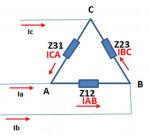BatmanisWatching1987
Senior Member
- Location
- NJ
- Occupation
- Jr. EE

[FONT="]
[/FONT]Here is the problem.
I am trying to practice solving for Apparent Power and Impedance.
I get different angles when I try solving for the apparent power.
Maybe I am using the Conjugate of the current incorrectly when solving for this problem.
I'm not sure what I am doing incorrectly.
View attachment 20190221224308.pdf




